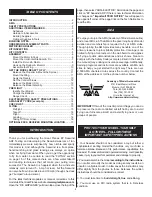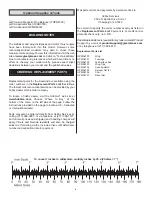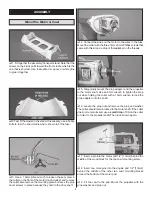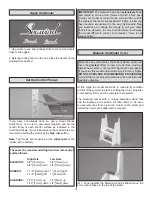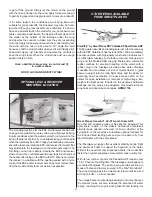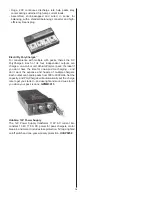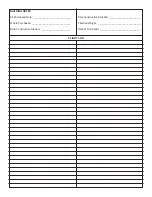
13
❏
2. Place the model upside-down on the balance stand as
shown. The leading edge of the wings should contact the vertical
“stop” on the stand, thus supporting the wing on the correct
C.G. location which is 1" [25mm] from the leading edge.
This is where your model should balance for the fi rst
fl ights. Later, you may wish to experiment by shifting the
C.G. up to 3/8" [10mm] forward or 3/8" [10mm] back to
change the fl ying characteristics. Moving the C.G. forward
may improve the smoothness and stability, but the model
may then require more speed for takeoff and make it more
diffi cult to slow for landing. Moving the C.G. aft makes
the model more maneuverable, but could also cause it to
become too diffi cult to control. In any case, start at the
recommended balance point and do not at any time
balance the model outside the specifi ed range.
❏
3. If the tail drops, the model is “tail heavy.” If possible,
you could mount the battery farther forward. Otherwise, lead
ballast will have to be added to the nose to get the model to
balance. If the nose drops, the model is “nose heavy” and
the battery pack could be shifted aft and/or weight could
be added to the tail. It is likely, though, that your model will
need an ounce or so of nose weight. If this is the case, place
incrementally increasing amounts of weight on the bottom
of the fuse over the location where it will be mounted inside
until you can get the model to balance. Once you know how
much weight is required place the model on the assembly
stand, remove the canopy and attach the weight inside. Great
Planes “stick-on” lead (GPMQ4485) is recommended and
should be placed inside the fuse as far forward as possible
while still leaving room for the battery.
❏
4. IMPORTANT: If you found it necessary to add any weight,
recheck the C.G. after the weight has been installed.
Balance the Model Laterally
Typically, a laterally balanced model will perform slightly better.
And while some modelers tend to overlook these last-minute
“fi ne tuning” procedures, we strongly urge you to laterally
balance your Seawind. Otherwise, the heavier wing may tend
to drag in the water causing the plane to “hook” as the model
is building speed for takeoff. If you don’t have easy access to
a body of water large enough to fl oat your Seawind to do the
lateral balance now, you could wait until you get to the lake (or
pond) and do the lateral balance right before your fi rst fl ight.
❏
1. With the model ready to fl y and the battery installed, set
the model in the water with the nose pointing into the wind.
❏
2. It will probably fl oat with one tip in the water and one tip up
out of the water. Tilt the wing so the “dry” tip is now in the water
and the “wet” tip is up. Do this several times, tipping the model
from side-to-side.
❏
3. If one tip always comes back down, then the opposite tip
will need some weight. Place incrementally increasing amounts
of weight on the “light” tip until neither tip is “favored” and the
wings can be rocked to either side without one tip always coming
back down.
❏
4. Stick the weight to the bottom of the wing next to the “light”
tip. Recheck the balance.
Note: Depending on how the model handles in the water, the
fi nal amount of weight may need to be adjusted.
PREFLIGHT
Identify Your Model
No matter if you fl y at an AMA sanctioned R/C club site or
if you fl y somewhere on your own, you should always have
your name, address, telephone number and AMA number
on or inside your model. It is required at all AMA R/C club
fl ying sites and AMA sanctioned fl ying events. Use a fi ne-
point felt-tip pen to write the information somewhere inside
the airplane such as on the bottom of the cockpit.
Charge the Batteries
Follow the battery charging instructions that came with your radio
control system to charge the transmitter batteries. You should
always charge your transmitter the night before you go fl ying,
and at other times as recommended by the radio manufacturer.
CAUTION: Unless the instructions that came with your
radio system state differently, the initial charge on new
transmitter and receiver batteries should be done for 15
hours using the slow-charger that came with the radio
system. This will “condition” the batteries so that the next
charge may be done using the fast-charger of your choice.
If the initial charge is done with a fast-charger the batteries
may not reach their full capacity and you may be fl ying with
batteries that are only partially charged.


